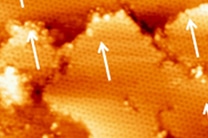In a recent study, a team of researchers from Italy and France have begun to investigate the fundamental properties and potential uses of 2D silicene, demonstrating that it can remain stable in the presence of oxygen for at least 24 hours.
The study, “24 h stability of thick multilayer silicene in air,” published on Monday in the Institute of Physics’ 2D Materials, details how thick multilayers of silicene, separated from parent silicone, can remain intact for up to 24 hours. This experiment, the most successful of its kind, could yield crucial information about silicene’s properties, potentially opening up its use as a conductive material in electronics.
Silicene is derived from honeycomb-shaped layers of silicone, which are only a single atom thick. Currently, silicene is created using a vacuum, which keeps oxygen from destroying the integrity of silicene’s fragile monolayers. Silicene is typically grown on a surface that resembles its own, like silver. To make silicene, a wafer of silicone is heated up to an extremely high temperature, causing single atoms of silicon to evaporate and land on the silver substrate, forming a monolayer of silicene.
While multiple 2D layers of silicene can be assembled on top of each other to form a 3D structure, scientists have previously found that such structures tend to be fairly unstable, eventually reverting back to much more stable silicone.

However, in this latest study, an international team of researchers have found that silicene has the potential to be quite stable – at least for 24 hours.
“These results are significant as we have shown that it is possible to obtain a silicon-based 2D material, which up until a couple of years ago was deemed inconceivable,” lead author of the study Paola De Padova, from Consiglio Nazionale delle Ricerche in Italy, said in a recent IOP press release.
To implement the study, the researchers assembled multilayers of silicene using a silver substrate at a temperature of 470°K, and solid silicone, kept at a temperature of 1,470°K. Using these materials, the scientists deposited 43 layers of silicene onto the silver.
The researchers observed shortly thereafter that a thin layer of oxidation formed on top of the multilayer stack of monolayered silicene. Interestingly, this layer of oxidation appeared to work as a layer of protection, preserving the integrity of the silicene stack.
This stack of silicene monolayers remained preserved for 24 hours in open air. During this time, the scientists confirmed using x-ray diffraction and Raman spectroscopy that the material was indeed silicene, not silicone.
“Our present study shows that multilayered silicene is more conductive than single-layered silicene, and therefore opens up the possibility of using it throughout the silicon microelectronics industry,” De Padova said. “In particular, we envisage the material being used as gate in a silicene-based MOSFET, which is the most commonly used transistor in digital and analogue circuits.”
“We are currently studying the possibility of growing multilayered silicene directly onto semiconductor substrates to explore the joint superconducting properties,” she added.
With further research, the researchers say, silicene’s still-untapped resources could one day be used towards a new generation of powerful electronics.
– Melanie Abeygunawardana






